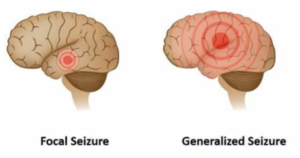 Different Types of Generalized Onset Seizures
Different Types of Generalized Onset Seizures
These seizures affect both sides of the brain or groups of cells on both sides of the brain at the same time. Generalized onset seizures include types such as tonic-clonic, absence, or atonic to name a few.
This type of seizure is what most people think of when they hear the word “seizure.” An older term for this type of seizure is “grand mal.” As implied by the name, they combine the characteristics of tonic and clonic seizures. Tonic means stiffening, and clonic means rhythmical jerking.
- The tonic phase comes first.
- All the muscles stiffen.
- Air being forced past the vocal cords causes a cry or groan.
- The person loses consciousness and falls to the floor.
- A person may bite their tongue or inside of their cheek. If this happens, saliva may look a bit bloody.
- After the tonic phase comes the clonic phase.
- The arms and legs begin to jerk rapidly and rhythmically, bending and relaxing at the elbows, hips, and knees.
- After a few minutes, the jerking slows and stops.
An absence seizure causes a short period of “blanking out” or staring into space. You may have heard it referred to as a “petit mal” seizure. Absence seizures usually affect only a person’s awareness of what is going on at that time.
There are two types of absence seizures that may look a bit different. Both types of seizures are short, and people often don’t notice them at first. They may come and go so quickly that no one notices anything wrong. Someone may mistake them for daydreaming or not paying attention.
-
- Typical Absence Seizures: These seizures are the most common, and they can be hard to catch as they usually last less than 10 seconds. Someone experiencing a typical absence seizure stops all activity. It may look like they are staring off into space or just has a blank look. There may be some subtle movements like fluttering eyelids or eyes turning upwards.
- Atypical Absence Seizures: These are called atypical because they can last up to 20 seconds, have a slower onset and offset, and have different symptoms. Like a typical absence seizure, it may look like the person is staring into space. Other symptoms include changes in muscle tone, fluttering eyelids or blinking, lip smacking or chewing, and hand motions like rubbing fingers together.
Myoclonic seizures are shock-like muscle jerks or twitches. Usually, myoclonic seizures only last a second or two. There can be just one, but sometimes multiple will occur within a short time.
Even people without epilepsy can experience myoclonus in hiccups or in a sudden jerk that may wake you up as you’re just falling asleep. These things are normal and are not seizures. In epilepsy, myoclonic seizures usually cause abnormal movements on both sides of the body at the same time. They occur in a variety of epilepsy syndromes that have different characteristics:
- Juvenile myoclonic epilepsy: The seizures usually involve the neck, shoulders, and upper arms. In many patients, the seizures most often occur soon after waking up. They usually begin around puberty or sometimes in early adulthood. In most cases, these seizures can be well controlled with medication, but it must be continued throughout life. Learn more…
- Lennox-Gastaut syndrome: This is an uncommon syndrome that usually includes other types of seizures as well. It begins in early childhood. These myoclonic seizures usually involve the neck, shoulders, upper arms, and often the face. They may be quite strong and are difficult to control. Learn more…
- Progressive myoclonic epilepsies: This category of rare genetic syndromes feature a combination of myoclonic seizures and tonic-clonic seizures. Treatment is usually not successful for very long, as the seizures cause damage over time. This may include worsening balance, coordination, and cognitive ability. Learn more…
In an atonic seizure, part or all of the body may suddenly become limp. You may have heard these be called “drop seizures” or drop attacks.” These seizures typically last less than 15 seconds and commonly start in childhood.
When an atonic seizure happens, try your best to make sure the person is in a safe place to prevent injuries and falls. If standing, the person often falls to the ground like a ragdoll and could injure themselves. Head protection, such as a helmet or other protective gear, may be needed. If sitting, their head or upper body may slump over. When the seizure starts in just one side of the brain, only parts of the body may be affected.
In some types of epilepsy (like Lennox-Gastaut or Dravet syndrome), seizures can happen in clusters with two or more at a time. If a person is at risk for seizure clusters, they should talk to their doctor or nurse about ways to treat clusters.
Muscle “tone” is the muscle’s normal tension at rest. In a tonic seizure, the tone is greatly increased: the body, arms, or legs become suddenly stiff or tense. They usually last less than 20 seconds, and a person may be aware during these seizures.
Tonic seizures usually happen during sleep and usually involve all or most of the brain, affecting both sides of the body. If they start in one side of the brain, only a part of the body may stiffen. If they start in both sides of the brain, the whole body may stiffen, and the person can fall. Head protection, such as a helmet or other protective gear, may be needed.
Tonic seizures are more common in people who have Lennox-Gastaut syndrome or other syndromes with mixed seizure types. Similarly, these movements may also be seen in other neurological problems too, especially in children.
It is very important to have a written description or video of what happens during a tonic seizure for a neurologist. For example, tonic seizures start suddenly with forceful movements. Events that start more slowly may be due to another condition.
“Clonus” means fast stiffening and relaxing of a muscle that happens repeatedly. In other words, it is repeated jerking. The movements cannot be stopped by restraining or repositioning the arms or legs. Most often, clonic movements are seen as part of a tonic-clonic seizure. They may affect one or both sides of the body, and they only last a few seconds to 1-2 minutes.
Unlike a myoclonic seizure, the jerking in a clonic seizure is more regular and sustained. Clonic and myoclonic seizures can be difficult to distinguish from one another.
Clonic seizures are rare and most commonly occur in babies. In infants, the clonic seizures are very brief and don’t happen very often. In fact, they could possibly go away on their own in a short period of time. If they do not go away, long-term treatment is necessary.




